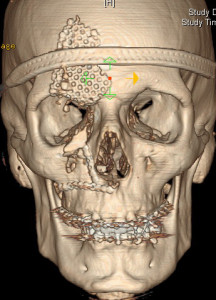 Facial Fractures
Facial Fractures
Nasal bones are the most common facial fracture, usually resulting from falls or altercations. In the first 2 weeks after the injury the bones can often be reset without making any incisions under anesthesia. Late presenting injuries require osteotomies (re-breaking the bone) to restore the normal bony architecture of your nose.
ZMC (zygomasticomaxillary complex) fractures are probably the second most common fracture. This fracture usually involves the orbital rim (lower eye socket), cheek bone (zygoma) and may also be associated with an orbital floor fracture. Displaced fractures can cause cheek asymmetry as well as sunken in appearance to the eye due to the abnormal eye socket anatomy. Unrepaired or inappropriately fixated fracture may require osteotomies (re-breaking the bone) to move the ZMC unit into anatomic position. Numbness of the cheek is quite common with these injuries.
Orbital floor fractures can cause sinking in of the eyeball and even affect the ability to move the eye normally causing double vision (diplopia). The orbital floor can be reconstructed using an implant (titanium, medpor) or a bone graft. The incision can be placed inside the eyelid to avoid visible facial scars.
Mandible fractures are also very common and may require surgery to fixate the mandible in the anatomic position using plates and screws. Frequently arch bars (wires around the teeth) are necessary to help obtain superior outcomes as well as better occlusion (ability of your teeth to meet together when you chew). Infection and poorly healed fractures may require osteotomies as well as bone grafts to properly heal the fracture.